Coastal building offers special possibilities and problems that call for creative design and careful planning. Adopting best practices that guarantee buildings are not just visually beautiful but also resilient and sustainable is vital given the continual threat of increasing sea levels, storms, and erosion. Marine Bulkheading SOE Construction New York, which provides crucial support and protection against environmental challenges.
Choosing the Right Materials
The lifetime of coastal buildings depends on careful choice of materials. High humidity, saltwater exposure, and strong UV radiation define often hostile coastal conditions. Thus, first priority should be materials that resist corrosion, such as treated wood, aluminum, and stainless steel, as well as those to further reduce the carbon footprint and boost the nearby economy. Think about also employing locally produced materials.
Elevation and Flood Resistance
In coastal architecture, raising buildings is a basic habit considering the increasing threat of sea-level rise. Constructing above the Base Flood Elevation (BFE) ensures that homes stay safe during flooding events and storm surges. Improved foundations not only guard buildings but also enable natural water flow, therefore lowering the erosion and damage risk. Pilings or stilts are among the creative design elements that might improve flood protection even while they keep visual appeal.
Incorporating Natural Barriers

Using natural barriers will help coastal buildings to be much more resilient. Strong winds and storm surges are prevented in part by vegetation like mangroves and dunes. Inclusion of these components in the design not only safeguards buildings but also increases coastal natural beauty and supports biodiversity. While supporting the nearby ecology, sustainable landscaping techniques can assist in preserving these natural barriers.
Adopting Sustainable Practices
Coastal building should have sustainability as its fundamental idea. Using renewable energy sources, rainwater collection, and energy-efficient equipment will help to reduce the environmental effect of new projects. Moreover, evaluating the life cycle of materials and their recyclability helps to support a more environmentally friendly building technique.
Designing for the components in coastal buildings requires a multifarious strategy with an eye toward sustainability, resilience, and aesthetics. Marine Bulkheading SOE Construction New York, which helps protect coastal structures from erosion and flooding. Builders may design buildings that resist the test of time and nature by knowing environmental elements, selecting appropriate materials, including natural barriers, and using sustainable techniques. Implementing these best practices will be absolutely essential for coastal towns’ future as we negotiate the effects of climate change.




